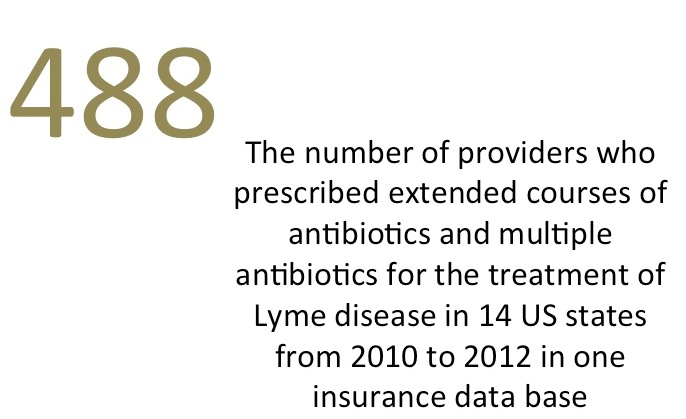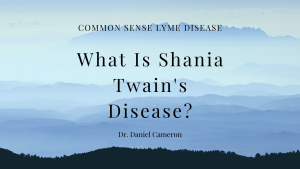Call for your appointment today 914-666-4665 | Mt. Kisco, New York

The Infectious Disease Society of America (IDSA) has long insisted that a maximum antibiotic course of 21 days is sufficient to eradicate the Lyme bacterium, while the International Lyme and Associated Diseases Society (ILADS) recommends a longer course of therapy with duration dependent on response to therapy. [1]
So, what treatment approach are physicians adopting in their own clinical practices? And how frequently are they prescribing multiple antibiotics to treat the disease? A recent study by Tseng and colleagues, published in the August issue of Clinical Infectious Diseases, aimed to answer those questions. They discovered, after reviewing insurance claims data, “that the use of extended courses of antibiotics and multiple antibiotics in the treatment of Lyme disease has increased in recent years.”
 The study examined the incidence and patterns of prolonged antibiotic treatment in Lyme disease (LD) patients in the Northeastern United States. The authors retrospectively analyzed health insurance claims for patients receiving Lyme disease treatment in 14 high-prevalence states from 2010 to 2012. [2] The 14 states were Connecticut, Delaware, Maine, Maryland, Massachusetts, Minnesota, New Hampshire, New Jersey, New York, Pennsylvania, Rhode Island, Vermont, Virginia and Wisconsin. [2]
The study examined the incidence and patterns of prolonged antibiotic treatment in Lyme disease (LD) patients in the Northeastern United States. The authors retrospectively analyzed health insurance claims for patients receiving Lyme disease treatment in 14 high-prevalence states from 2010 to 2012. [2] The 14 states were Connecticut, Delaware, Maine, Maryland, Massachusetts, Minnesota, New Hampshire, New Jersey, New York, Pennsylvania, Rhode Island, Vermont, Virginia and Wisconsin. [2]
Typically, studies only include Lyme disease patients who meet the Centers for Disease Control and Preventions’ (CDC) two-tier diagnostic testing criteria. All others, are excluded. However, the two-tiered antibody testing is not an accurate method, since it requires positive results on both the poorly sensitive ELISA and Western blot tests. In fact, previously, a study conducted by Wormser and colleagues concluded that only one-third of well-characterized Lyme disease patients could be confirmed by the CDC’s two-tier diagnostic criteria. [3]
Since this study is all-inclusive and not restricted by patients passing the two-tier test, it offers a unique insight into actual treatment practices and is more representative of the patient population afflicted with Lyme disease.
According to the study, 18% of Lyme disease patients were treated for more than 5 weeks (defined as extended therapy by the authors). The actual length of time patients were prescribed antibiotics was much longer with an average of 86 days. Treatment duration ranged from 35 to 404 days.
Nearly half of Lyme disease patients (48.8%) were treated with more than 2 antibiotics. Doxycycline was prescribed in as many as 74.4% of LD patients. Azithromycin was prescribed in as many as 11.5% of LD patients. Amoxicillin and cefuroxime were also prescribed. The study did not look at additional antibiotics, such as minocycline and tetracycline, typically prescribed to treat other tick-borne illnesses.
The use of extended therapy also involved switching from one antibiotic to another and/or combinations of antibiotics. The study found, 43% of patients were switched from one antibiotic to another, while 18% were prescribed combinations of antibiotics.
It was not a surprise that a small group of doctors prescribed extended therapy for a significant number of Lyme disease patients. These 16 doctors (3%) treated more than 20% of the Lyme disease patients, who were prescribed extended antibiotic treatment.
However, the findings that hundreds of other providers, listed in a single insurance database in the Northeastern U.S., prescribed extended antibiotics was surprising. In other words, 472 doctors treated the remaining 80% of Lyme disease patients with extended therapy.
It was also surprising to find that those 16 doctors actually did not differ from their 472 peers in prescribing extended courses of antibiotics. However, the prescribing patterns did differ between the 16 doctors, who treated more than 20% of the Lyme disease patients, and their 472 colleagues, when measuring the average number of antibiotic exposure days, the number of refills in the longest drug era, and the combination of antibiotics prescribed.
The authors did not address why 488 doctors treated their Lyme disease patients longer than the 21 days recommended by the 2006 Infectious Disease Society of America (IDSA) evidence based guidelines. [1]
In addition, the authors did not mention that there are, in fact, doctors who have recommended extended antibiotic therapy for select patients based on a risk-benefit assessment and shared medical decision. [4] The following excerpt from the International Lyme and Associated Diseases Society (ILADS) evidence based guidelines describes the risk–benefit assessment needed when making a shared medical decision.
“The clinical population of patients with persistent manifestations of Lyme disease is heterogeneous; therefore, the risk–benefit assessment needs to be done on an individualized basis, taking into account the severity of an individual’s persistent disease, their responsiveness to treatment, their ability to tolerate side effects associated with additional and potentially long-term treatment as well as their willingness to accept the risk associated with antibiotic treatment or, conversely, the level of their desire to avoid treatment-associated risk.” [2]
Medical societies continue to debate the optimal treatment regimen. In the mean time, doctors have to use clinical judgment when treating their Lyme disease patients. The paper demonstrates that hundreds of doctors are choosing extended antibiotic therapy in an effort to successfully treat their patients.
Sources:
- Wormser GP, Dattwyler RJ, Shapiro ED et al. The clinical assessment, treatment, and prevention of lyme disease, human granulocytic anaplasmosis, and babesiosis: clinical practice guidelines by the Infectious Diseases Society of America. Clin Infect Dis, 43(9), 1089-1134 (2006).
- Tseng YJ, Cami A, Goldmann DA, DeMaria A, Jr., Mandl KD. Incidence and Patterns of Extended-Course Antibiotic Therapy in Patients Evaluated for Lyme Disease. Clin Infect Dis, (2015).
- Molins CR, Ashton LV, Wormser GP et al. Development of a metabolic biosignature for detection of early Lyme disease. Clin Infect Dis, 60(12), 1767-1775 (2015).
- Cameron DJ, Johnson LB, Maloney EL. Evidence assessments and guideline recommendations in Lyme disease: the clinical management of known tick bites, erythema migrans rashes and persistent disease. Expert Rev Anti Infect Ther, 1-33 (2014).




It is very exciting to see that more and more research seems to be taking place relating to Lyme disease diagnosis, complexity of symptoms, and range of treatment. Thank you for your consistent part in this.
Good to see science slowly starting to win out. Refer to science adn evidence based ILADS guidelines.
Good to see science slowly starting to win out. Refer to science and evidence based ILADS guidelines.
daniel, thanks for the report above and i noted you, betty maloney, and lorraine johnson wrote/published your latest study!! good deal 😉
9-8-15, i met betty mahoney 1st time in white bear, minn. when i heard nc bart expert, dr. ed breischwedt, sp, speak! she got me to the meeting place since i’m from IOWA.
thanks for my upper tonight; i posted it on lyme site i post in.
THANKS FOR ALL YOU DO DANIEL and serving as ilads pres/past pres. i can’t keep up whose pres. now..neuro lyme of 46.5 yrs.
bettyg, iowa activist
MISDIAGNOSED 35 yrs. by 40-50 drs.
UNACCEPTABLE!
This doesn’t answer anything about why it’s politicized. I’m getting tired of looking I’ve been looking for 45 minutes now and I can’t find a decent reason or even any reason really except that doctors are aligned with insurance corporations yeah well prove it I mean, I’m looking for hard research compared to other hard research what the hell? You guys are not helping. You’re not helping us understand why it’s politicized. In your article all you did was compared treatment modalities that’s all. That doesn’t answer anything. No wonder this whole thing is such a mess